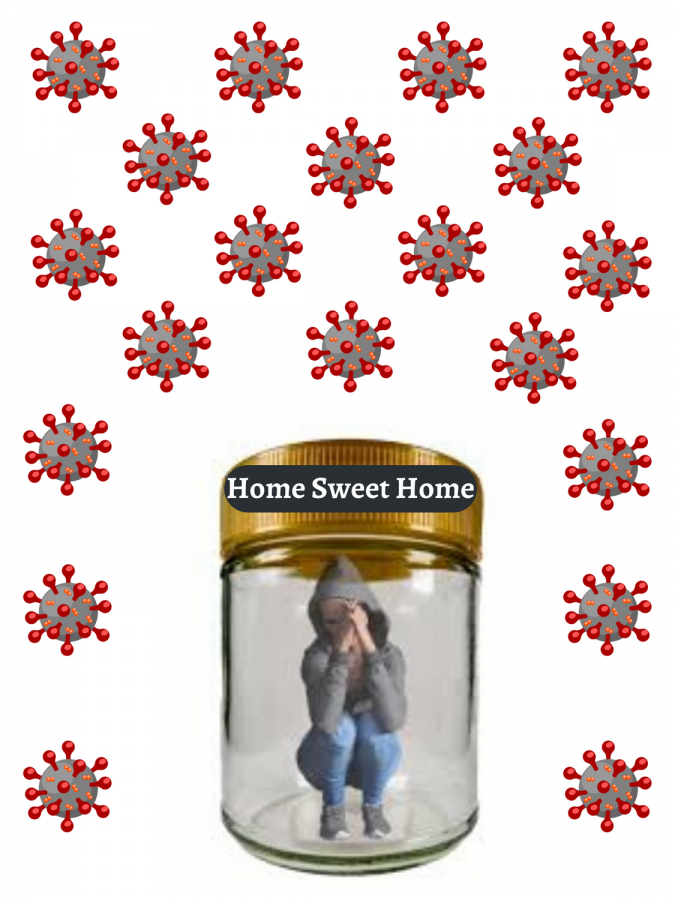Domestic violence rates spike as lockdown continues
For many, “home, sweet home” doesn’t ring true as COVID-19 forces situations of domestic abuse.
May 28, 2020
Domestic violence rates are surging as shelter-in-place protocols for COVID-19 trap victims of domestic abuse in vulnerable situations at home.
Travel restrictions and shelter-in-place protocols have been placed in order to prevent the spread of the virus. While many are making up for missed time with their families, trying new activities, and catching up on some sleep, victims of domestically abusive situations are experiencing the opposite. Staying in close quarters in a dangerous environment with less access to external resources lends more opportunity to possible physical, verbal, emotional, and sexual abuse.
Anita Bhatia, the Deputy Executive Director of the United Nations Women, explains to TIME the tradeoff between lockdown safety and domestic violence rates: “While we absolutely support the need to follow these measures of social distancing and isolation, we also recognize that it provides an opportunity for abusers to unleash more violence.”
Although quarantining at home has created more opportunities for domestic abuse to occur, the added stress and uncertainty that COVID-19 has brought on has been driving them to become more violent as well. Stress over getting sick, losing jobs, and losing family members have led some to lash out more violently and often than before, creating new abusers and exacerbating the circumstances with existing ones.
Katie Ray Jones, the CEO of the National Domestic Violence Hotline, emphasizes the increase in the causes of domestic violence due to the ongoing crisis.
“We know that domestic violence is rooted in power and control. Right now, we are all feeling a lack of control over our lives and an individual who cannot manage that will take it out on their victim,” she said.
For intimate partner violence specifically, the financial strain goes both ways. While abusers are becoming more frustrated with the inevitable loss of income that the COVID-19 crisis has brought on, victims of intimate partner abuse are also losing their jobs, making it even harder for them to leave. However, even if victims are able to leave, they have very limited options to where they can go. Travel restrictions and fears of exposure to the virus prevent them from going to the homes of other friends and family. Hospitals aren’t a good option either as victims would be increasing their risk of catching the virus by being near infected patients.
Ray-Jones believes that abusers are using these fears to prevent their partners from leaving.
“Perpetrators are threatening to throw their victims out on the street so they get sick. We’ve heard of some withholding financial resources or medical assistance,” she said.
However, intimate partner abuse isn’t the only type of domestic abuse that’s on the rise due to lockdown. The reduced amount of calls regarding child abuse and neglect on domestic violence hotlines has created concerns that child abuse is increasing as well. Minna Castillo Cohen, the director of the Colorado Office of Children, Youth and Families explains why she believes more abuse is happening now than before.
“We are concerned about this significant drop in calls, particularly because children and youth who may be experiencing abuse and neglect are now home all day and isolated.”
While a reduced amount of calls sounds like the problem is being solved, it’s actually the opposite. Less calls are happening because the people who want to call and were calling are now unable to. Kids facing abusive situations are unable to call, as their perpetrators are always around, making it unsafe for them to do so.
With the closure of schools, educators and social workers are separated from the children they want to help. Emily Putnam-Hornstein, a professor of social work at the University of Southern California, explains to The Atlantic why less calls potentially means more abuse.
“All the normal contacts that children would have … a therapist, or a teacher, or a doctor — everything is being canceled. It leaves me quite nervous.”
For many students, the closure of schools allows them to finally destress. But for others, the stress is now magnified. For them, college serves as an escape, where they can be their true selves with acceptance and support. Back under their parents’ roofs, many have returned to traumatic environments where they’re unaccepted, neglected and abused.
A senior at Princeton University who was forced to return home explained to his administration why he was reluctant to return home.
“I felt backed into a corner,” he said. “I really can’t go home. I would feel unsafe at the only place where I could find a bed.”
In the case of John, a transgender and gay student, college was the only place where he felt supported. When his college closed due to the pandemic, he was forced to leave behind his only support system and either live under his parent’s roof, where he would have to live by their conservative rules or be forced to go to conversion therapy, or to live on the streets in his car, where he could be exposed to the virus, harassed, and even sexually assaulted.
Chinyere Ezie, a staff attorney at the Center for Constitutional Rights expresses the reality of the pandemic for LGBT students that are in vulnerable households.
“With all of the closures that have resulted from the COVID-19 pandemic, you have fewer resources than ever for transgender and LGBT students and youth who are looking for support and for resources,” she said. “It’s really no laughing matter that people are being forced back into the closet, so to speak, just to be able to survive this pandemic.”
While these lockdown policies are necessary in order to protect the general public, it’s also causing an unintended consequence that hasn’t been as highlighted in mainstream news. Ezie explains the consequences of neglect and ignorance to those that are suffering in their homes.
“All of the groups and all the communities that were vulnerable, that were discarded, that were neglected in America prior to this crisis are the ones that are going to continue to suffer and suffer most immensely. Every single demographic that was basically being impacted by structural inequality prior to this epidemic is feeling the brunt of this crisis to an exponential degree.”


